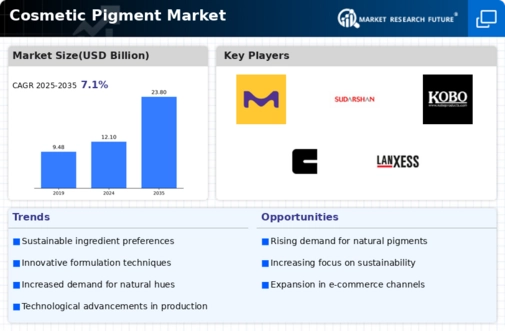Cosmetic Pigments Size
Cosmetic Pigments Market Growth Projections and Opportunities
The cosmetic pigments market is influenced by various factors that shape its trends and growth patterns. One of the primary drivers of this market is the increasing demand for cosmetic products across the globe. As consumer preferences evolve and beauty trends change, there is a growing demand for cosmetics that offer vibrant colors, long-lasting effects, and superior performance. Cosmetic pigments play a crucial role in achieving these desired characteristics, as they impart color, shimmer, and texture to a wide range of cosmetic products such as lipsticks, eyeshadows, nail polishes, and foundations. As the cosmetics industry continues to grow, driven by factors such as changing fashion trends, increasing disposable incomes, and growing beauty consciousness, the demand for cosmetic pigments also rises, driving market growth.
Technological advancements in pigment manufacturing processes also significantly impact the cosmetic pigments market. Manufacturers are continually innovating to develop pigments with improved properties such as better color intensity, stability, and compatibility with various cosmetic formulations. Advanced production techniques such as nano-particle technology enable the production of pigments with smaller particle sizes, resulting in better color dispersion, higher color payoff, and enhanced skin adherence. These technological innovations drive market expansion by offering cosmetic companies a wide range of pigment options to create innovative and high-quality cosmetic products.
Moreover, regulatory standards and safety considerations play a vital role in shaping the cosmetic pigments market. Regulatory bodies such as the FDA (Food and Drug Administration) and European Commission impose strict regulations regarding the safety and purity of cosmetic ingredients, including pigments. Compliance with these regulations is essential for cosmetic manufacturers to ensure the safety and efficacy of their products. Additionally, consumer awareness of ingredient safety and concerns about potential health risks associated with certain pigments drive the demand for natural and organic pigments derived from plant-based sources, minerals, and other eco-friendly materials.
The competitive landscape of the cosmetic pigments market also influences its growth trajectory. With numerous players competing for market share, competition is intense in terms of product quality, innovation, and pricing. Manufacturers invest in research and development to introduce new pigment formulations, improve production efficiency, and develop customized solutions tailored to meet the specific needs of cosmetic brands and consumers. Strategic collaborations, partnerships, and acquisitions are common strategies employed by companies to strengthen their market presence and gain a competitive edge.
Furthermore, economic factors such as GDP growth, urbanization, and changing consumer lifestyles impact the cosmetic pigments market. Economic growth stimulates consumer spending on beauty and personal care products, driving the demand for cosmetic pigments. Moreover, urbanization and changing consumer preferences for premium and high-quality cosmetics drive the demand for innovative and trendy pigment formulations, further fueling market growth.









Leave a Comment